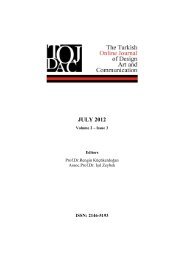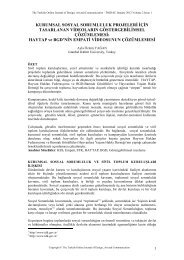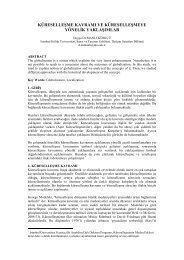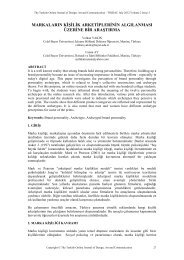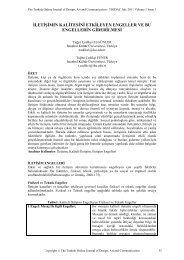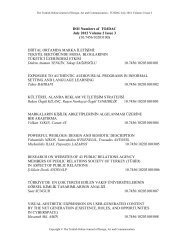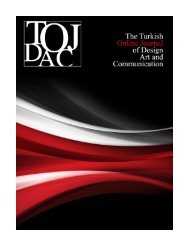aprıl 2012 - tojdac.org
aprıl 2012 - tojdac.org
aprıl 2012 - tojdac.org
You also want an ePaper? Increase the reach of your titles
YUMPU automatically turns print PDFs into web optimized ePapers that Google loves.
The Turkish Online Journal of Design, Art and Communication - TOJDAC April <strong>2012</strong> Volume 2 Issue 2<br />
three dimensional objects. So Augmented Reality enhances a user's perception of and<br />
interaction with the real world. [1]<br />
Figure 3. “555 Kubic” by UrbanScreen.Projection Mapping. Hamburg,Germany.2009.<br />
Within the new dimensions of the frame, hybrid media always keeps changing and effect the<br />
frame as a whole. Manovich points out the transformations in the frame such as<br />
transformation of visual elements, transparency of objects, textures of the images etc. and if<br />
something stays same for a while, that’s an exception rather than the norm. [10]<br />
4. TYPOGRAPHY IN HYBRID MEDIA<br />
The word typography is already a hybrid of type and graphics. Considering that multimedia is<br />
a hybrid of various conventional media such as cinematography, animation, graphic design<br />
and typography, we need to acknowledge that typography is more or less a hybrid of text and<br />
image. [5]<br />
Although the hybridization of type has started so long ago, the process become much more<br />
accelerated with the help of technological tools. In the 1970’s, a digital signal began to<br />
supplant the photographic negative as the means of reproducing the typographic forms. In the<br />
electronic environment of contemporary type design, scanned alphabets can ben endlessly<br />
manipulated by the type designer, serving either as models for accurate reproduction or as<br />
skeletons for new or hybrid designs. [9] Now in the digital era, there are limitless<br />
opportunities to manipulate and embed type into the image whether it’s moving or not.<br />
Hillner suggests that from a design perspective a typographic message is composed rather<br />
than written. The arrangement of words, sentences and blocks lends the text an image-like<br />
quality. Due to it’s metalinguistic architectural characteristics, typography is scanned as well<br />
as read.[5]<br />
Samara evaluates the relationship between type, word and image as an interaction between<br />
them happens as a result of their similar abstract pictorial qualities. Both images and type<br />
share the same attributes such as lighting, volume, contours, open and closed spaces and<br />
arrangements. She emphasizes the task is to find where the specific attributes of both come<br />
together. [13] The visual relationship between type and image is different in hybrid media,<br />
because of the continuous movement and transformation of the image. Motion typography is<br />
as old as the cinema, but the demand in juxtaposing type with the image is much more<br />
challenging today. For example, embedding three dimensional typography into moving<br />
images needs more visual attributes like shadows, depth of field, perspective and motion<br />
rather than just overlaying layers.<br />
Copyright © The Turkish Online Journal of Design, Art and Communication 103



